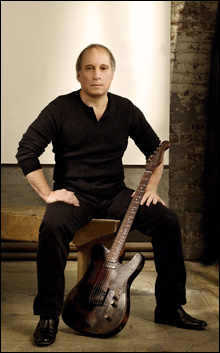When Paul Simon reunited with Art Garfunkel in 2003 for a nostalgia tour and a live double-CD cash-in, Old Friends, I wasn’t alone in thinking, “That’s it, then, he’s thrown in the towel.” Reunion tours are big business, but they’re also the last refuge of an ailing (and aging) talent. This one did come as a surprise, because Simon, despite his ties to the ’60s folk movement and the purple haze of sentiment that surrounds that era, has always been forward-thinking and even radical. His 1972 Paul Simon solo debut, a pan-cultural stew combining elements of reggae, cool jazz, and South American rhythms, was miles away from the Technicolor pop of Bridge over Troubled Waters. In 1986, he brought South African mbaqanga into the mainstream with Graceland, which found both artistic and commercial success.Simon’s best recordings have been based on his own personal discoveries of regional, worldbeat, and exotic rhythms. From the Dixieland lilt of There Goes Rhymin’ Simon to the Brazilian bounce of The Rhythm of the Saints, he long ago proved that he’s not your ordinary acoustic-pickin’ poetry man. Weaker work like his lost-in-the-’80s clunker, Hearts and Bones, lacked oomph on the bottom and focus at the top.
His last few albums have seen him struggling. The Capeman, his 1997 foray into Broadway musicals, was a disaster: the story about a Puerto Rican thug turned poet was strained and its songs were unmemorable. Three years later, Paul returned with You’re the One, a singer-songwriterly meditation on mortality.

RHYTHM-A-NING: Brian Eno has helped him produce his best work in years.
|
Now Surprise (Warner Bros.), more continuation than comeback, finds the 64-year-old artist on new and fertile ground. He’s added to his palette oblique strategist and musical magpie Brian Eno as producer, pouring his liquid melodies and affecting, stream-of-conscious lyrics over Eno’s phalanx of peculiar sonic textures and angular and (sometimes) jagged rhythms. The combo makes sense if you compare, say, Eno’s work on Talking Heads’ Remain in Light with Graceland. Both albums point popular music in what was then untraveled territory. And the pair’s pull and tug achieves a kind of avant-folk balance.The real story, though, is that Simon has penned some of his most affecting songs, addressing the fragility of life — specifically, the part of life where the end is much closer than the beginning — in his own elliptical fashion. His words are poetic and conversational; the sounds they make blend with Eno’s aural atmospherics like so much colored air. The tunes at first seem elusive, unconventional, devoid of structure. But then a subtly gorgeous refrain pops out of “Everything About It Is a Love Song.” Your head starts bobbing to the funked-up “Sure Don’t Feel like Love”; you’re won over by the walking wounded of “Wartime Prayers.” One by one the songs latch onto you, and with each subsequent playing they become more vivid. And that’s the magic of Surprise.
On the Web
Paul Simon:http://www.paulsimon.com/